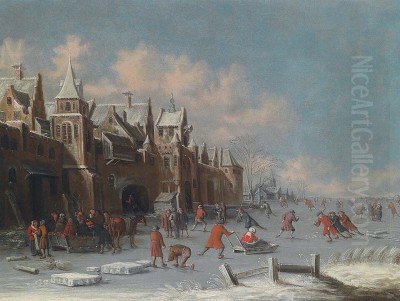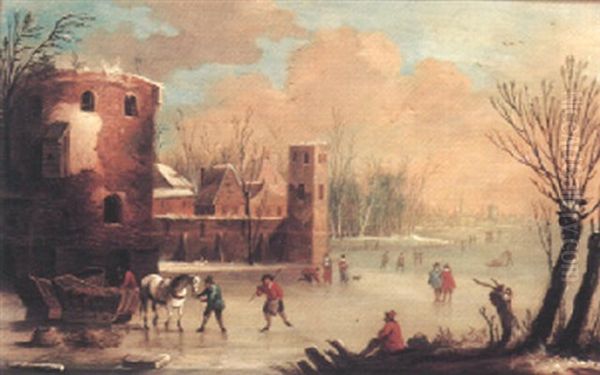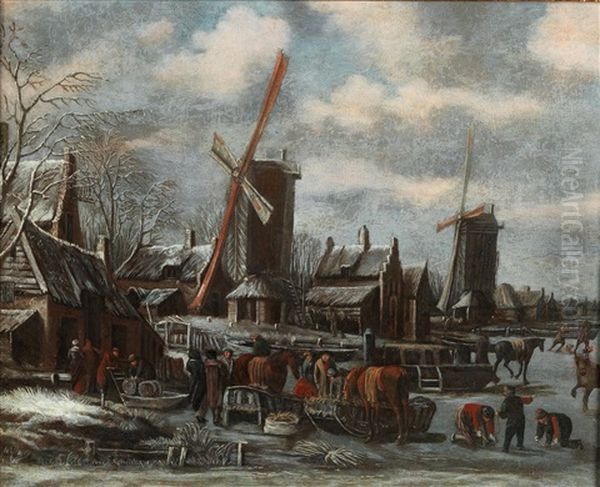
Thomas Heeremans stands as a notable figure within the rich tapestry of Dutch Golden Age painting. Active during the latter half of the 17th century, he carved a distinct niche for himself, becoming particularly renowned for his evocative depictions of winter landscapes. Born and deceased in the vibrant artistic hub of Haarlem, Heeremans captured the quintessential atmosphere of the Netherlands during its coldest months, leaving behind a legacy of charming, atmospheric scenes that continue to resonate with viewers today.
Haarlem's Artistic Soil
Thomas Heeremans entered the world in Haarlem around 1640. This city was not merely his birthplace; it was a crucible of artistic innovation during the Dutch Golden Age. Haarlem boasted a thriving community of painters, supported by a strong local market and the influential Guild of Saint Luke, which regulated the training and practice of artists. Growing up in this environment undoubtedly shaped Heeremans' artistic path. The city was already famous for its landscape painters, including masters like Jacob van Ruisdael and Salomon van Ruysdael, whose works set a high standard for naturalistic depiction and atmospheric depth. While Heeremans developed his own distinct style, the artistic currents of Haarlem provided a fertile ground for his development.
The demand for art in the 17th-century Dutch Republic was widespread, extending beyond the aristocracy to the burgeoning merchant class. This created opportunities for artists specializing in various genres, including portraits, still lifes, marine scenes, genre paintings, and landscapes. Landscape painting, in particular, flourished, reflecting a national pride in the Dutch land and a fascination with the effects of light and weather. Heeremans emerged within this context, choosing to focus primarily on landscape, with a special affinity for the unique challenges and beauties of the winter season.
The Influence of Molenaer
Artistic development rarely occurs in isolation, and Thomas Heeremans' style shows the clear imprint of his contemporaries. Art historians widely recognize the significant influence of Claes Molenaer (also known as Nicolaes Molenaer) on Heeremans' work. Molenaer, another Haarlem-based painter active slightly earlier and concurrently with Heeremans, was also known for his landscape paintings, including numerous winter scenes.

The similarities can be seen in their compositional approaches and thematic choices. Both artists frequently depicted frozen canals bustling with activity, often framed by rustic buildings and bare trees under expansive skies. Molenaer's influence likely extended to Heeremans' handling of light and atmosphere, particularly the rendering of the crisp, cold air and the muted palettes characteristic of overcast winter days. While Heeremans developed his own recognizable hand, the foundational elements provided by Molenaer's example are undeniable, placing Heeremans firmly within the Haarlem landscape tradition.
Capturing the Dutch Winter
Heeremans is most celebrated for his winter landscapes. These paintings typically depict frozen rivers or canals teeming with figures engaged in various winter activities – predominantly skating, but also sledding, conversing, or simply traversing the ice. His scenes often possess a strong sense of Dutch rural or village life. Humble cottages, windmills, and occasionally notable town landmarks provide architectural interest and anchor the compositions.
A defining characteristic of Heeremans' winter scenes is their atmosphere. He excelled at conveying the specific quality of light on a cold day, often employing a palette dominated by cool greys, blues, and whites, punctuated by the warmer tones of brick buildings or the colourful attire of the figures. His skies are frequently overcast, contributing to a slightly somber yet peaceful mood, accurately reflecting the northern European winter climate. These are not dramatic, idealized landscapes, but rather intimate glimpses into the everyday life of the Netherlands during winter.
The popularity of winter scenes during the Dutch Golden Age was immense. Artists like Hendrick Avercamp had pioneered the genre earlier in the century, creating detailed, narrative-rich panoramas. Heeremans continued this tradition but often focused on slightly broader, more atmospheric compositions compared to Avercamp's intricate, bird's-eye views. His work resonated with a public that appreciated depictions of familiar Dutch life and the unique beauty found in the winter season. The recurring motif of skaters on ice reflects a popular pastime and a symbol of Dutch resilience and enjoyment even in harsh conditions.
Signature Style and Techniques
Heeremans typically worked in oil, often on wooden panels, a common practice for cabinet-sized paintings in the 17th century. His brushwork is generally detailed yet efficient, capturing the textures of snow, ice, bare branches, and brickwork with skill. While his landscapes form the main subject, the figures populating them are essential to their charm and liveliness. Though sometimes painted with less individual detail than the figures in works by dedicated genre painters like Jan Steen or Adriaen van Ostade, Heeremans' figures are animated and effectively convey the sense of community and activity on the ice.

His compositions are often structured along diagonal lines, leading the viewer's eye into the scene, typically following the course of a frozen waterway. He balanced areas of activity with calmer stretches of snow or ice, creating a pleasing visual rhythm. The interplay of light and shadow, even under a muted winter sky, was handled with sensitivity, defining forms and adding depth to the scene. He often repeated successful compositions or motifs, varying details like the specific arrangement of figures or the background architecture. This practice was common among artists meeting market demand and indicates the popularity of his particular formulas.
Representative Works
Several paintings exemplify Thomas Heeremans' style and subject matter. One notable example often cited is Paesaggio invernale con figure sul ghiaccio (Winter Landscape with Figures on Ice). The Italian title likely reflects its provenance or cataloguing in an Italian collection, but the scene itself is quintessentially Dutch. It showcases his characteristic elements: a frozen waterway, numerous small figures skating and interacting, rustic buildings, bare trees, and a dominant, atmospheric grey sky. Such works highlight his ability to create a cohesive and believable winter world.
Another significant work, often discussed due to its collaborative nature, depicts a Frozen Canal near the Montelbaanstoren, Amsterdam. This painting, sometimes identified as showing the Oude Schans canal, is notable because Heeremans collaborated with the marine and cityscape painter Abraham Storck. In this partnership, Heeremans typically painted the landscape and architectural setting, while Storck, known for his skillful rendering of figures and ships, added the lively staffage. The Montelbaanstoren, a distinctive 16th-century tower that was part of Amsterdam's defenses, provides a recognizable landmark, grounding the winter scene in a specific location.
A painting depicting the Coast at Egmond demonstrates that Heeremans occasionally ventured beyond pure winter scenes, though landscapes remained his focus. The mention of such a work appearing at auction, fetching between £1,500 and £2,000 in 2016, gives insight into his continued presence and value in the art market. While perhaps less iconic than his winter views, beach and coastal scenes were also a popular subgenre within Dutch landscape painting, practiced by artists like Jacob van Ruisdael and Jan van Goyen.
Collaboration with Abraham Storck
The collaboration between Thomas Heeremans and Abraham Storck (or Sturck) is a fascinating aspect of 17th-century Dutch artistic practice. Specialization was common, and artists often teamed up, combining their respective strengths to create a more accomplished final product. Storck, based primarily in Amsterdam, was highly regarded for his detailed and accurate depictions of ships, harbour scenes, and city views, often populated with lively figures.

In their joint works, such as the aforementioned view featuring the Montelbaanstoren, the division of labour seems clear: Heeremans provided the atmospheric landscape setting – the frozen canal, the snow-covered banks, the winter sky, and the architectural framework – while Storck contributed the numerous figures animating the scene. This partnership allowed both artists to play to their strengths, resulting in paintings that combined Heeremans' landscape sensibility with Storck's figurative skill. Such collaborations underscore the interconnectedness of the art world in cities like Haarlem and Amsterdam.
Contemporaries and the Wider Artistic Context
Thomas Heeremans worked during a period of extraordinary artistic production in the Netherlands. To fully appreciate his contribution, it's helpful to consider him alongside other prominent painters of the era. In landscape painting alone, the field was rich with talent. Besides his likely influence, Claes Molenaer, Heeremans' contemporaries included giants like Jacob van Ruisdael, whose dramatic and emotive landscapes set a benchmark, and Meindert Hobbema, known for his idyllic woodland scenes.
Other landscape specialists included Jan van Goyen and Salomon van Ruysdael, masters of the tonal landscape style popular earlier in the century. Aert van der Neer specialized in evocative moonlight scenes and winter landscapes, often focusing on the effects of light on snow and ice, providing an interesting comparison to Heeremans' daytime winter views.
Beyond pure landscape, the Dutch Golden Age saw masters in other genres whose work sometimes intersected thematically. Philips Wouwerman, also from Haarlem, often included exquisite horses and figures in his landscape settings, sometimes depicting winter activities. Genre painters like Adriaen van Ostade and Jan Steen captured scenes of peasant life and middle-class interiors, offering different perspectives on the daily life that Heeremans depicted outdoors. Marine painting, crucial for a seafaring nation, flourished with artists like Willem van de Velde the Younger and Jan van de Cappelle capturing the power and beauty of the sea, sometimes including frozen harbours that relate to Heeremans' winter themes. Even portraitists like Frans Hals, Haarlem's most famous artist, contributed to the city's vibrant artistic reputation. This broader context highlights the specialization yet interconnectedness of the Dutch art scene where Heeremans practiced.
Later Life and Legacy
Details about Thomas Heeremans' personal life remain relatively scarce, a common situation for many artists of this period who did not achieve the fame level of a Rembrandt or Vermeer. We know he was active as a painter primarily in Haarlem throughout his career. His consistent production of winter landscapes suggests he found a ready market for his work. He passed away in Haarlem in 1697, the same city where he was born.
His legacy lies primarily in his contribution to the genre of Dutch winter landscape painting. While perhaps not as innovative as Avercamp or as dramatic as Ruisdael, Heeremans perfected a particular type of atmospheric, accessible winter scene that captured the spirit of the Dutch Golden Age. His paintings offered charming vignettes of everyday life, rendered with competent skill and a keen eye for the nuances of the winter environment.
Today, Thomas Heeremans' works are held in various public collections, including prestigious institutions like the Rijksmuseum in Amsterdam and, as noted in some sources, potentially the Gemäldegalerie in Düsseldorf (though precise gallery names can sometimes be ambiguous in historical records). His paintings continue to appear on the art market, appreciated by collectors for their decorative appeal and their authentic glimpse into 17th-century Dutch life. He remains a recognized name among specialists of the period, valued for his consistent quality and his focus on a beloved theme in Dutch art. The absence of documented anecdotes or dramatic life events, as contrasted with figures like the playwright Herman Heijermans mentioned in the source material, simply reinforces that his reputation rests squarely on the merits of his artistic output.
Enduring Appeal
The enduring appeal of Thomas Heeremans' paintings stems from several factors. His winter landscapes evoke a sense of nostalgia and charm, depicting activities and scenes that feel both historically specific and universally relatable. The depiction of community, resilience, and simple pleasures amidst the cold resonates across time. His skill in capturing the particular atmosphere of a Dutch winter day – the quality of the light, the feel of the cold air, the textures of snow and ice – demonstrates a mastery of his craft.
Furthermore, his work serves as a valuable historical document, offering visual insights into the environment, architecture, clothing, and pastimes of the Netherlands in the 17th century. For art historians and enthusiasts, his paintings provide a clear example of the Haarlem landscape tradition and the broader trends within Dutch Golden Age art. While operating within established conventions, Heeremans brought his own sensitivity and consistent vision to his chosen specialty, securing his place as a respected master of the Dutch winter scene. His art continues to offer a window onto a specific time and place, rendered with skill and enduring charm.